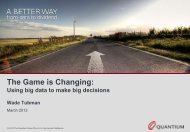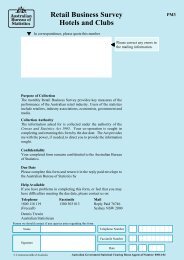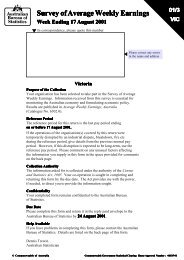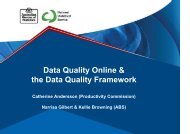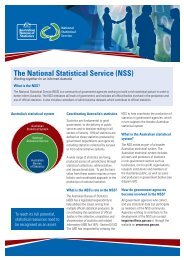SAE Manual Sections 1 to 4_1 (May 06).pdf - National Statistical ...
SAE Manual Sections 1 to 4_1 (May 06).pdf - National Statistical ...
SAE Manual Sections 1 to 4_1 (May 06).pdf - National Statistical ...
Create successful ePaper yourself
Turn your PDF publications into a flip-book with our unique Google optimized e-Paper software.
A Guide <strong>to</strong> Small Area Estimation - Version 1.1 05/05/20<strong>06</strong><br />
for some small areas or units. Such differences, therefore, call for a more general/flexible<br />
specification of the models <strong>to</strong> capture the area-specific (person-specific) fac<strong>to</strong>rs after<br />
taking account of the auxiliary variables - and hence the random effects models. Thus,<br />
the choice between random effects models versus synthetic models could be made on<br />
the basis of one or more of the following fac<strong>to</strong>rs:<br />
i.<br />
ii.<br />
iii.<br />
iv.<br />
v.<br />
prior knowledge of small areas or units vis-a-vis the auxiliary data gained from<br />
experience or through discussions with subject matter specialists,<br />
users/stakeholders, etc. (for example, we may not have a lot of faith in our auxiliary<br />
variables /the synthetic model).<br />
from statistical outcomes based on the models. A close assessment or evaluation of<br />
the small area estimates/predictions from comparative synthetic and random effects<br />
models and see whether they meet expectations.<br />
on the basis of statistical/econometric tests (a battery of diagnostic and statistical<br />
tests) on the adequacy of the models.<br />
when one wants small areas with large samples <strong>to</strong> be less affected by the model<br />
because the direct estimates for such areas can be expected <strong>to</strong> be quite reliable in<br />
their own right. The random effects model allows for a suitable trade-off between the<br />
reliability of the direct estimates and reliability of model estimates.<br />
when one wants <strong>to</strong> apply the model <strong>to</strong> areas with no sample in them (out of sample<br />
areas). Random effects models allow for greater flexibility in applying the model <strong>to</strong><br />
make predictions for areas other than those <strong>to</strong> which it was fitted.<br />
Clearly, once the random effects models are chosen they require a higher level of<br />
statistical skill and some familiarity with specialised software. It is also true that more<br />
complex models may not necessarily provide better results. This is particularly true if<br />
sufficiently strong relationships in the data, from which <strong>to</strong> borrow strength, are simply<br />
not present in the data. One should be aware that results from simple models may be as<br />
good as those from complex ones. In other words, as will be discussed later in this<br />
section, the gains in efficiency of estimates from using more complex models need <strong>to</strong> be<br />
assessed.<br />
An important aspect of the modeling process which may also have significant bearing on<br />
the complexity and quality of the analysis is whether the variable of interest involves a<br />
univariate or multivariate analytical framework. Here we are specifically referring<br />
whether the variable of interest is a univariate or multivariate form. For example, in the<br />
disability study, if our variable of interest is simply <strong>to</strong> predict whether a person has an<br />
impairment or not (i.e., 1= person has a disability and 0= person has no disability)<br />
regardless of the type of impairment then this is within a univariate framework. On the<br />
other hand, a breakdown of the variable of interest by type of impairment (e.g., physical,<br />
mental, sensory etc.) would involve a multivariate framework. The real issue here is that<br />
while a univariate analysis is simpler <strong>to</strong> undertake, a multivariate analysis provides an<br />
opportunity <strong>to</strong> exploit additional information on the correlations that exist between the<br />
various types of impairment and hence improve the reliability of estimates.<br />
Australian Bureau of Statistics 32




